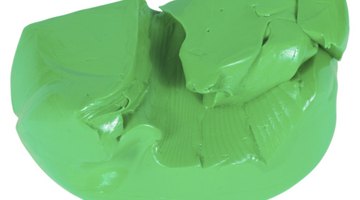How to Remove Silly Putty From Rubber
Odds are, at some point in your life, you have cracked open a plastic egg of Silly Putty and gave it a stretch or two. According to the official Silly Putty website, Silly Putty came about quite by accident in 1943 when a scientist named James Wright was trying to develop synthetic rubber.

Silly Putty is a combination of silicone oil and boric acid and coloring. Silly Putty provides hours of fun for kids, and sometimes hours of cleaning for parents. Removing Silly Putty from rubber can be challenging, but with enough determination it can be accomplished.
Things You Will Need
- Dinner knife (optional)
- Car part lubricant
- Cleaning cloth
- Rubbing alcohol
- Cotton balls
- Sponge
- Water
- Liquid dish detergent
Tip
Car part lubricant effectively removes Silly Putty from rubber because of the de-greasing properties of the lubricant. Because the lubricant contains no silicone like Silly Putty, the lubricant penetrates the putty, loosening it from the rubber surface beneath. If Silly Putty remnants remain after you have wiped the putty and rubber with lubricant and with alcohol, continue to repeat the application of the lubricant and/or alcohol until the Silly Putty is removed.
-
Remove as much of the Silly Putty as possible from the rubber surface. If you don’t think the rubber will be harmed, use the blunt end of a dinner knife to scrape the putty away. There are many Silly Putty clones sold under other brand or store names. The basic properties are the same; even if another brand name of putty is adhered to the rubber surface, the same cleaning techniques are effective.
-
Spray the Silly Putty and rubber around the putty remnants with a car part lubricant. Wait about three minutes for the lubricant to work under the putty. According to Crayola, as endorsed by the Silly Putty brand, use a cleaning cloth to wipe away the putty remnants.
-
Soak cotton balls in rubbing alcohol and scrub any remaining Silly Putty stuck to the rubber and/or the rubber surface in a back-and-forth motion.
-
Apply liquid dish detergent to a damp sponge and clean the car part lubricant and alcohol residue from the rubber surface. Because of the silicone compounds in the Silly Putty, the putty clings to rubber and plastics more than other products. According to the official Silly Putty website, the combination of silicone oil and boric acid creates what is referred to as a solid liquid, which allows the product to bounce, stretch and be molded.
The Drip Cap
- Odds are, at some point in your life, you have cracked open a plastic egg of Silly Putty and gave it a stretch or two.
- Spray the Silly Putty and rubber around the putty remnants with a car part lubricant.
- According to Crayola, as endorsed by the Silly Putty brand, use a cleaning cloth to wipe away the putty remnants.
- According to the official Silly Putty website, the combination of silicone oil and boric acid creates what is referred to as a solid liquid, which allows the product to bounce, stretch and be molded.
References
Resources
Writer Bio
Louise Harding holds a B.A. in English language arts and is a licensed teacher. Harding is a professional fiction writer. She is mother to four children, two adopted internationally, and has had small businesses involving sewing and crafting for children and the home. Harding's frugal domestic skills help readers save money around the home.
Photo Credits
- Hemera Technologies/PhotoObjects.net/Getty Images
- Hemera Technologies/PhotoObjects.net/Getty Images
More Articles



